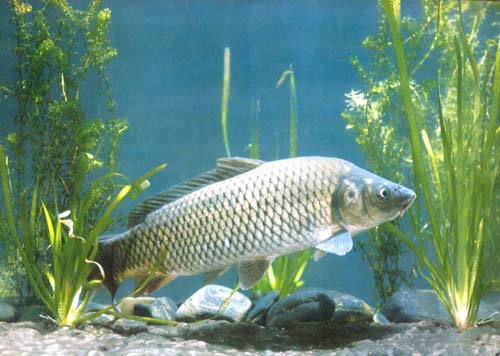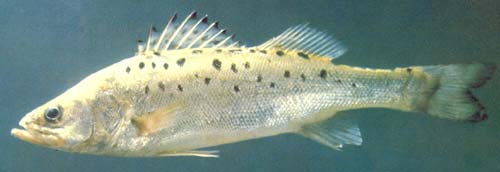The statistical results in different works at different times vary greatly. According to rough statistics from the recently published "Chinese Vertebrate Encyclopedia" and the currently being compiled "Chinese Zoology", there are 1,050 species of fish distributed in China's freshwaters (including coastal estuaries), belonging to 18 orders, 52 families, and 294 genera. Among them, there are 967 species of pure freshwater fish, 15 species of sea and river migratory fish, and 68 species of estuarine fish. Among these thousand and fifty species of fish, they can generally be divided into the following four categories:

Cyclostome lamprey
1. Cylostomes: This type of fish is the most primitive fish-shaped vertebrate. The fish has no real upper and lower jaws, and its mouthparts form suckers, leading to a parasitic or semi-parasitic life. There is no real spine in the body, only a notochord. In terms of evolutionary periods, cyclostomes were first discovered in the Middle Ordovician, and were most developed in the Silurian and Lower Devonian. By the Lower Devonian, they gradually became extinct, with only a few species remaining to this day. In my country's freshwater, only three species of lamprey live in rivers from Heilongjiang to Liaohe in Northeast China.
2. Cartilage fish: Cartilaginous fish were discovered in the Upper Devonian Period and were most developed in the Carboniferous Period. As they continued to evolve, they became modern sharks and rays. The bones of this type of fish are all cartilage, the scales are small shield scales, and there are spiral valves in the intestines. This is a group of lower-level true fish. Almost all living cartilaginous fish live in the ocean, and only a few species live in fresh water. Among them, apart from red rays living in large numbers in the ocean, a small group of them has settled in Guangxi, my country. In the Zuojiang River of the Xijiang River system from Nanning to Longzhou, red rays are a marine fish based on their evolutionary history. According to ancient geological research, Guangxi was originally an ocean. Due to the orogeny of the earth's crust, at the end of the Pliocene Era of the Cenozoic Era, when the seawater withdrew from Guangxi, it was "land sealed" and settled in inland water bodies.



3. Cartilage fish: This type of fish is a bony fish, but the skeletal system is cartilaginous. The scales on the body surface are bony rhombus-shaped primitive scales, the tail fin is crooked, and the intestine has spiral valves. Primitive cartilaginous fish appeared in the Devonian Period and survived on the earth for a long time. By the Mesozoic Era, most species became extinct. The living sturgeon fish appeared in the Cretaceous period, and there are not many species surviving now. They are only distributed in the Arctic Ocean at high latitudes. There are one species of Acipensidae and 2 genera and 8 species of Acipensidae living in the freshwater of my country.
4. Teleost fish: This is a common and real fish in modern times. It is the most popular fish in modern times. Among the one thousand and fifty species of freshwater fish in China, except for a few species (13 species) , almost all of which are teleost fishes. The freshwater fish in China are dominated by Cypriniformes, especially carpidae, which account for about half of the total. Among them, the order Herringiformes has 1 family, 3 genera and 5 species, the order Salmoniformes has 6 families, 17 genera and 32 species, the order Anguiformes has 1 family, 1 genus and 2 species, the order Cypriniformes has 6 families, 170 genera and 740 species, and the order Cypriniformes has 10 species, 27 genera and 110 species. There are 4 species in 2 families, 3 genera and 4 species in the order Mediformes, 4 species in 1 family, 1 genus and genus in the order Aniformes, 1 family, 1 genus and 1 species in the order Grylliformes, 2 species in 1 family, 2 genera and 2 species in the order Acanniformes, and 7 species in 1 family, 3 genera and 7 species in the order Mulliformes. , Synbranchiformes, 1 family, 1 genus and 1 species, Perciformes, 12 families, 51 genera and 110 species, Scorpiformes, 1 family, 4 genera and 8 species, Plaiceiformes, 3 families, 3 genera and 5 species, Pleuromorphs, 1 family, 2 genera and 6 species species, with a total of 1037 species in 15 orders, 49 families.


Teleost fishes appeared in the Jurassic Period. During the Cretaceous Period, ancient teleost fishes evolved into modern teleost fishes, and their morphological structures underwent major changes. The upper and lower jaws of the skull are generally shortened, the advanced type of maxilla is specialized into a toothless bone rod, the teeth are concentrated on the front jaw, the caudal fin becomes a completely symmetrical tail or orthomorphic tail, the endoskeleton is highly ossified, and the odd fin Both the fins and the even fins show various shapes. The pelvic fins are often moved from the abdomen to the head, and the scales become very thin and rounded. The internal and external structures of teleost fishes are equipped with complete aquatic adaptation structures. Starting from the Cretaceous, they developed along many radiation adaptation routes, making them inhabitants of all waters on the earth's surface.
animal tags:
We created this article in conjunction with AI technology, then made sure it was fact-checked and edited by a Animals Top editor.